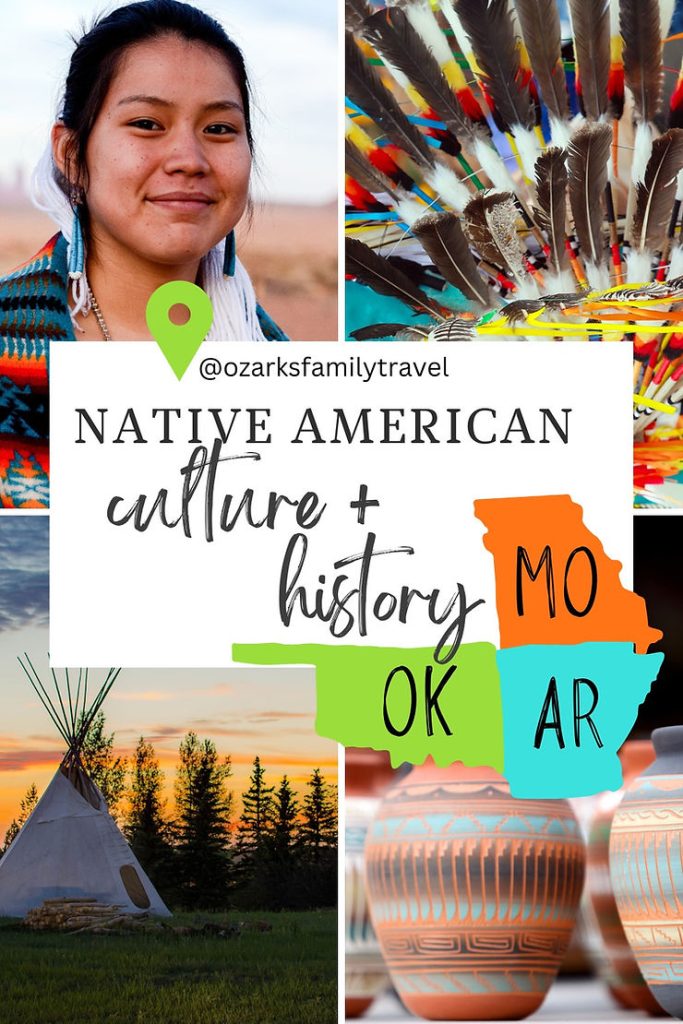Native American history and culture is a deeply rooted in the Ozarks. Luckily, there are plenty of places for families to visit and learn important lessons about Native American culture and history. Find one today in:
Missouri | Arkansas | Oklahoma
A big part of exploring a new area is learning about the history–good and bad, that forged the cultural streams of the region. In the Ozarks, the breathtaking beauty of mountains, rivers, streams, and lakes have attracted humankind for centuries.

Heads up: This page contains affiliate links. That means if you click and buy—we may receive a small commission at no additional cost to you. Read more about it here.
The Native Americans of the Ozarks
Native American influence in the Ozarks comes from two significant periods of time. First, pre-European settlement, dozens of tribes called the hills of the Ozarks home. Second, a darker period in American history occurred when the Indian Removal Act of 1830 relocated thousands of Native Americans to designated land in Oklahoma, bringing many more tribes to the Ozarks region as they made their difficult journey to the Indian lands in Oklahoma.
Some of the earliest and most established tribes of the Ozarks include:
Eastern Ozarks:
- Kaskaskia
- Cahokia
- Peoria
- Saukees
Western Ozarks:
- Pawnee
- Osage
- Choctaw
After the purchase of Missouri in the Louisiana Treaty (1803), additional tribes were granted land in the Ozarks, including:
- Kickapoo
- Cherokee
- Delaware (Lenape)
- Quapaw
Native American History & Cultural Experiences
If you’re looking for something meaningful or educational to do with your family, consider exploring the deep veins of Native American history and culture across the Ozarks. The beauty and natural geography of the Ozarks region spoke to many different tribes over the years.

Native Americans enjoyed the cover of the hills for hunting and the clear rivers, streams, and lakes for water as they called the Ozarks home. In the late 1830’s, these tribes and many more were forcibly resettled in Oklahoma, making their way through the Ozarks region on the Trail of Tears.
Missouri Ozarks
The Missouri Ozarks are home to well-preserved historic sites featuring proof of prehistoric tribes and Ice Age animals, early petroglyphs inscribed by early inhabitants, documented historical sites from early expeditions, and observed sacred grounds like Onondaga and the most well-preserved ancient native civilization in the US–Cahokia Mounds which is less than 10 miles across the Missouri state line into Illinois.
Points of Interest:
- Museum of Ozark Indians in Mansfield, MO
- Cahokia Mounds Ancient Native Civilization in Collinsville, IL
- Mastodon State Historic Site in Imperial, MO
- Clark’s Hill at Norton State Historic Site in Jefferson City, MO
- Missouri State Museum in Jefferson City, MO
- Onondaga Cave State Park in Leasburg, MO
- Trail of Tears State Park in Jackson, MO
- Native American Cultural Center at Van Meter State Park in Miami, MO
- Meramec Spring Park in St. James, MO
- Osage Village State Historic Site in Walker, MO
- Iliniwek Village State Historic Site in Wayland, MO
- Wonders of Wildlife Museum in Springfield, MO

Arkansas Ozarks
Did you know that the city of Fort Smith, Arkansas was primarily founded as a rally point for the US government to manage attacks on the Cherokee Indians by the fiercely defensive Osage Indians? Arkansas is also regrettably well-known for its place on the Trail of Tears, the path taken during the forced removal of Indians East of the Mississippi in the 1830s.
Points of Interest:
- Museum of Native American History in Bentonville, AR
- Toltec Archeological State Park in Scott, AR
- Parkin Archeological State Park in Park, AR
- Trail of Tears Park in Fayetteville, AR
- University of Arkansas Native American Collections
- Fort Smith National Historic Site
- Indian Rock Cave & Trail on the Buffalo River
Oklahoma Ozarks
Oklahoma became the forced settlement for thousands of Native Americans as they were relocated west of the Mississippi. The journey that these tribes made to the West is historically known as the Trail of Tears, where many lost their lives to exposure and illness.
If you’re looking to explore the roots of Native American culture, you don’t have to look very far. There are historic sites, museums, and present-day experiences in all four corners of the state. However, the most notable experience might be the tourist-friendly reservation belonging to Cherokee Nation in Tahlequah, Oklahoma.
Points of Interest:
- Cherokee Nation in Tahlequah, Oklahoma
- The Spiro Mounds Archeological Center
- Chickasaw Cultural Center in Sulphur, OK
- Choctaw Nation Museum in Tuskahoma, OK
- Five Tribes Museum in Muskogee, OK
- Shop Dozens Native American Retailers in Pawhuska, OK
While you’re in Pawhuska, pick up a copy of Killers of the Moonflower, a best-selling non-fiction novel with film adaptation filmed in Pawhuska with the cooperation of the current-day leaders of Osage Nation.
Are You Ready to Book Your Trip to the Ozarks and Experience Native American Culture Up Close?
Let us help you find a good deal to make the most of your Ozarks family vacation.
Book a Hotel: Find a place to stay by the lake on Trip.com.
Rent a Car: Rent a car to take you on a journey through the historical Native American sites in the Ozarks. Compare and save with Economy Bookings.
